Spatiotemporal Variability of Chlorophyll-a and Sea Surface Temperature, and Their Relationship with Bathymetry over the Coasts of UAE
Abstract
:1. Introduction
2. Study Area and Dataset
2.1. Study Area
2.2. Dataset
2.2.1. Chl-a Data
2.2.2. SST Data
2.2.3. Bathymetry Data
3. Methodology
3.1. Filling Missing Data
3.2. Empirical Orthogonal Function (EOF) Analysis
3.3. Correlation Analysis
3.4. Correlated Seasonal Mann–Kendal Trend Test
4. Results and Discussion
4.1. Spatiotemporal Distribution of Chl-a and SST
4.2. Variability in Chl-a and SST
4.3. Correlation of Chl-a and SST
4.4. Trend Analysis
5. Summary and Conclusions
Author Contributions
Funding
Data Availability Statement
Acknowledgments
Conflicts of Interest
Appendix A
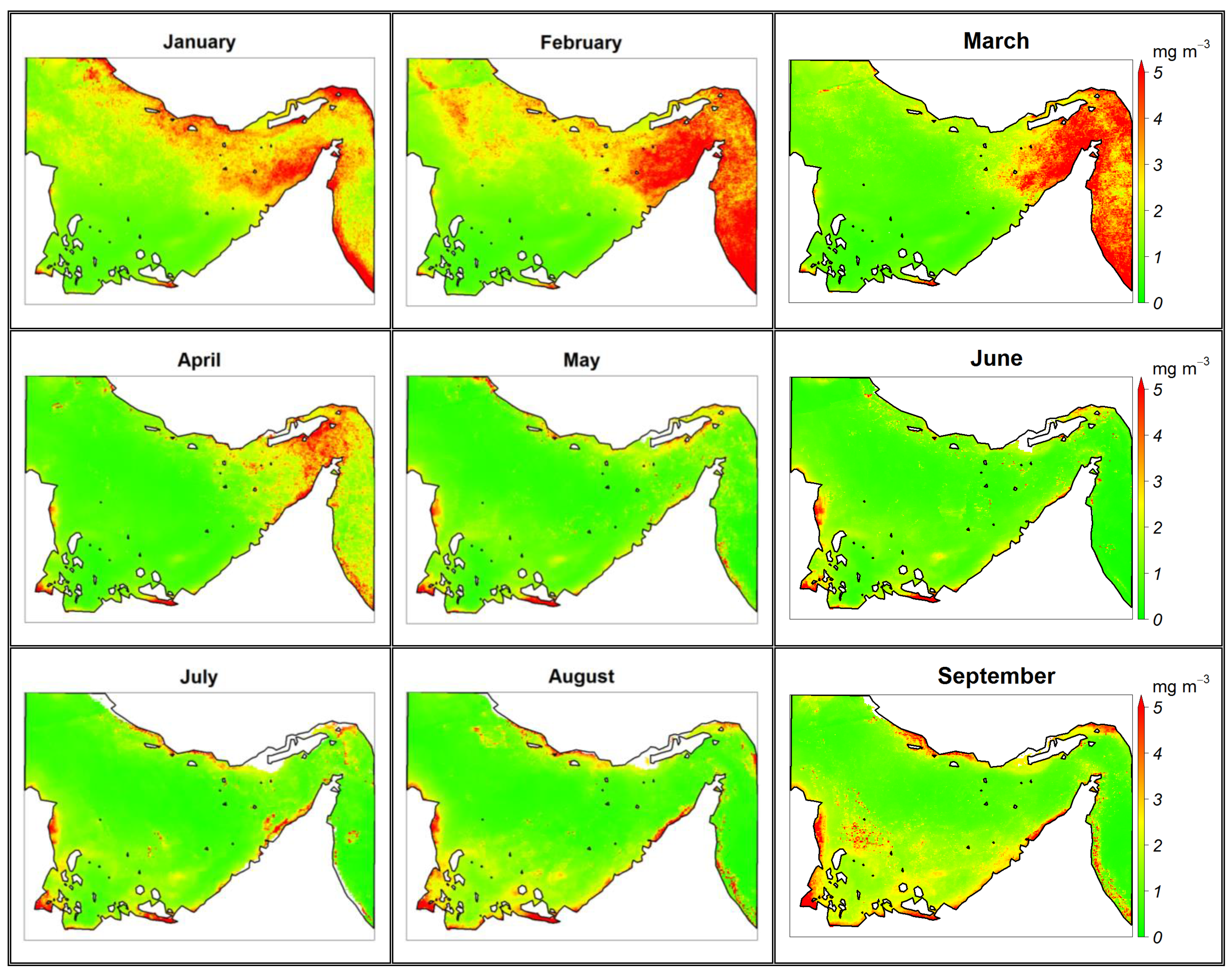

Appendix B


Appendix C

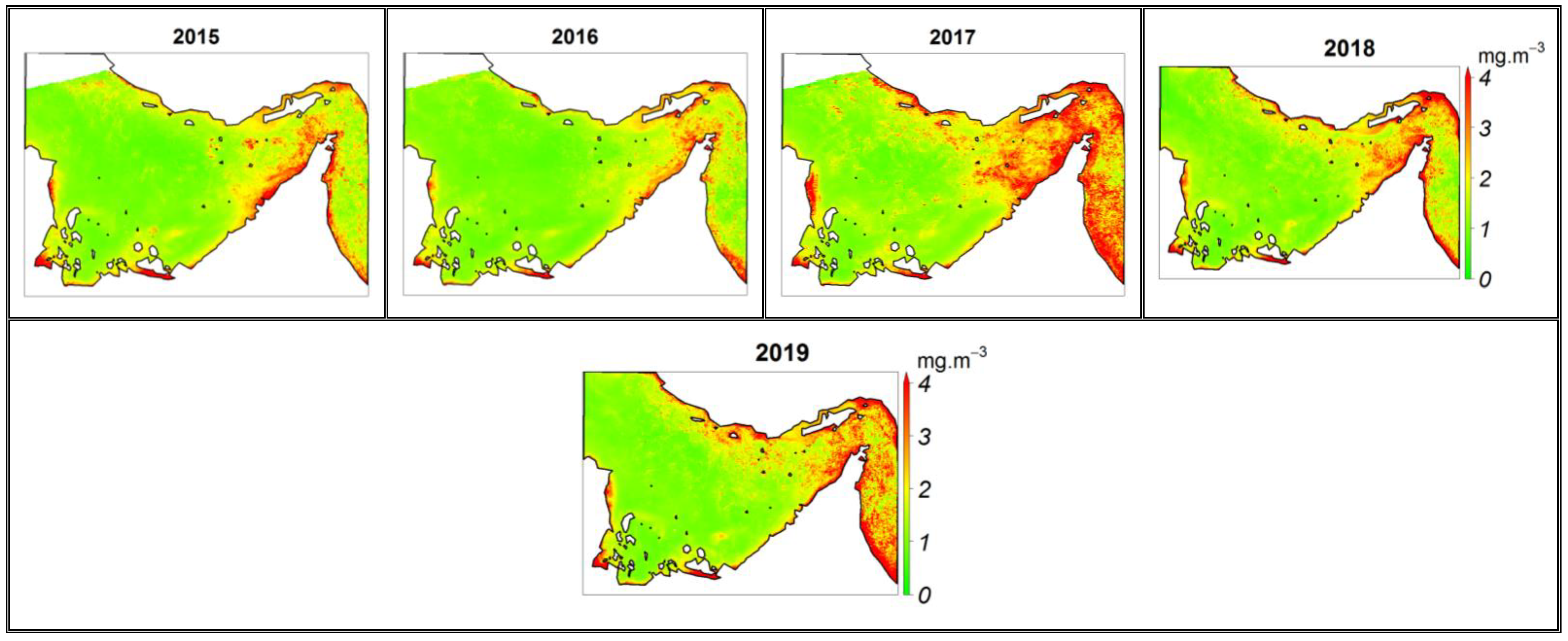
Appendix D

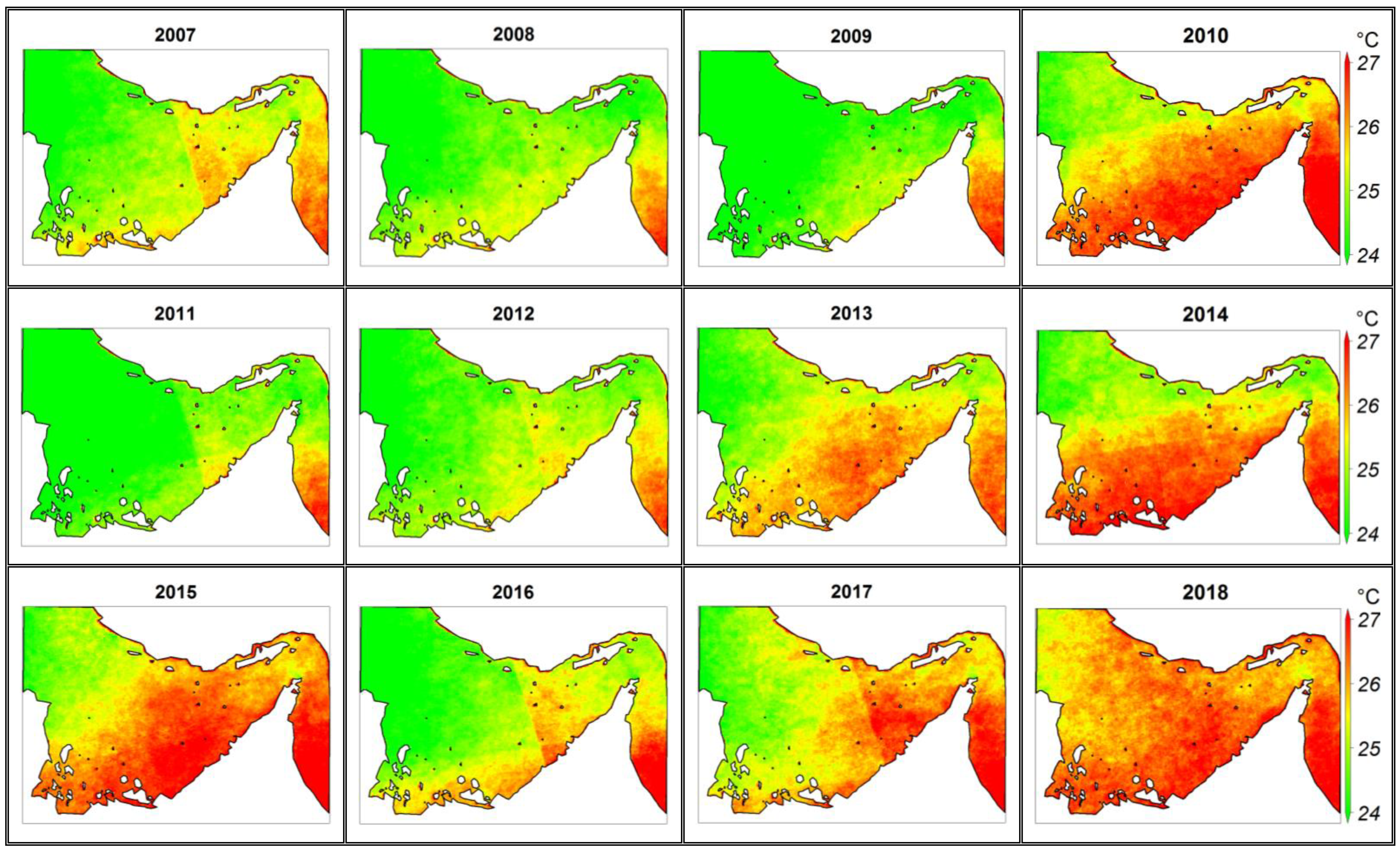

References
- Al Shehhi, M.R.; Gherboudj, I.; Ghedira, H. An overview of historical harmful algae blooms outbreaks in the Arabian Seas. Mar. Pollut. Bull. 2014, 86, 314–324. [Google Scholar] [CrossRef]
- do Rosario Gomes, H.; Goes, J.I.; Matondkar, S.P.; Parab, S.G.; Al-Azri, A.R.; Thoppil, P.G. Blooms of Noctiluca miliaris in the Arabian Sea—An in situ and satellite study. Deep. Sea Res. Part I Oceanogr. Res. Pap. 2008, 55, 751–765. [Google Scholar] [CrossRef]
- Zhao, J.; Ghedira, H. Monitoring red tide with satellite imagery and numerical models: A case study in the Arabian Gulf. Mar. Pollut. Bull. 2014, 79, 305–313. [Google Scholar] [CrossRef]
- Sastry, J.; d’Souza, R. Upwelling and upward mixing in the Arabian Sea. Indian J. Geo Mar. Sci. 1972, 1, 17–27. [Google Scholar]
- Wiggert, J.; Jones, B.; Dickey, T.; Brink, K.; Weller, R.; Marra, J.; Codispoti, L. The Northeast Monsoon’s impact on mixing, phytoplankton biomass and nutrient cycling in the Arabian Sea. Deep. Sea Res. Part II Top. Stud. Oceanogr. 2000, 47, 1353–1385. [Google Scholar] [CrossRef]
- Barzandeh, A.; Eshghi, N.; Hosseinibalam, F.; Hassanzadeh, S. Wind-driven coastal upwelling along the northern shoreline of the Persian Gulf. Boll. Geofis. Teor. Appl. 2018, 59, 301–312. [Google Scholar]
- Chaichitehrani, N.; Allahdadi, M.N. Overview of wind climatology for the Gulf of Oman and the northern Arabian Sea. Am. J. Fluid Dyn. 2018, 8, 1–9. [Google Scholar]
- Banse, K. Seasonality of phytoplankton chlorophyll in the central and northern Arabian Sea. Deep Sea Res. Part A Oceanogr. Res. Pap. 1987, 34, 713–723. [Google Scholar] [CrossRef]
- Kumar, S.P.; Ramaiah, N.; Gauns, M.; Sarma, V.V.S.S.; Muraleedharan, P.M.; Raghukumar, S.; Dileep Kumar, M.; Madhupratap, M. Physical forcing of biological productivity in the Northern Arabian Sea during the Northeast Monsoon. Deep Sea Res. Part II Top. Stud. Oceanogr. 2001, 48, 1115–1126. [Google Scholar] [CrossRef]
- Banse, K.; English, D.C. Comparing phytoplankton seasonality in the eastern and western subarctic Pacific and the western Bering Sea. Prog. Oceanogr. 1999, 43, 235–288. [Google Scholar] [CrossRef]
- Palanisamy, S.; Ahn, Y.-H.; Ryu, J.-H.; Moon, J.-E. Application of optical remote sensing imagery for detection of red tide algal blooms in Korean waters. In Proceedings of the 2005 IEEE International Geoscience and Remote Sensing Symposium—IGARSS’05, Seoul, Korea, 25–29 July 2005; IEEE: New York, NY, USA, 2005. [Google Scholar]
- Blondeau-Patissier, D.; Gower, J.F.; Dekker, A.G.; Phinn, S.R.; Brando, V.E. A review of ocean color remote sensing methods and statistical techniques for the detection, mapping and analysis of phytoplankton blooms in coastal and open oceans. Prog. Oceanogr. 2014, 123, 123–144. [Google Scholar] [CrossRef] [Green Version]
- Prigent, C.; Aires, F.; Rossow, W.B. Land surface skin temperatures from a combined analysis of microwave and infrared satellite observations for an all-weather evaluation of the differences between air and skin temperatures. J. Geophys. Res. Atmos. 2003, 108. [Google Scholar] [CrossRef]
- Miles, T.; He, R. Seasonal surface ocean temporal and spatial variability of the South Atlantic Bight: Revisiting with MODIS SST and Chl-a imagery. Cont. Shelf Res. 2010, 30, 1951–1962. [Google Scholar] [CrossRef]
- Alvera-Azcárate, A.; Barth, A.; Beckers, J.M.; Weisberg, R.H. Multivariate reconstruction of missing data in sea surface temperature, chlorophyll, and wind satellite fields. J. Geophys. Res. Oceans 2007, 112. [Google Scholar] [CrossRef] [Green Version]
- Petchprayoon, P. Analysis of Climate Change Impacts on Surface Energy Balance of Lake Huron (Estimation of Surface Energy Balance Components: Remote Sensing Approach for Water–Atmosphere Parameterization); University of Colorado at Boulder: Boulder, CO, USA, 2015. [Google Scholar]
- Brewin, R.J.; Raitsos, D.E.; Pradhan, Y.; Hoteit, I. Comparison of chlorophyll in the Red Sea derived from MODIS-Aqua and in vivo fluorescence. Remote Sens. Environ. 2013, 136, 218–224. [Google Scholar] [CrossRef]
- Hu, C.; Lee, Z.; Franz, B. Chlorophyll aalgorithms for oligotrophic oceans: A novel approach based on three-band reflectance difference. J. Geophys. Res. Oceans 2012, 117. [Google Scholar] [CrossRef] [Green Version]
- Nezlin, N.P.; Kostianoy, A.G.; Grégoire, M. Patterns of seasonal and interannual changes of surface chlorophyll concentration in the Black Sea revealed from the remote sensed data. Remote Sens. Environ. 1999, 69, 43–55. [Google Scholar] [CrossRef]
- Tang, D.-L.; Ni, I.-H.; Kester, D.R.; Müller-Karger, F.E. Remote sensing observations of winter phytoplankton blooms southwest of the Luzon Strait in the South China Sea. Mar. Ecol. Prog. Ser. 1999, 191, 43–51. [Google Scholar] [CrossRef] [Green Version]
- Gurlin, D.; Gitelson, A.A.; Moses, W.J. Remote estimation of chl-a concentration in turbid productive waters—Return to a simple two-band NIR-red model? Remote Sens. Environ. 2011, 115, 3479–3490. [Google Scholar] [CrossRef]
- Gower, J.F.; King, S.A. Distribution of floating Sargassum in the Gulf of Mexico and the Atlantic Ocean mapped using MERIS. Int. J. Remote Sens. 2011, 32, 1917–1929. [Google Scholar] [CrossRef]
- Gower, J.; King, S.; Goncalves, P. Global monitoring of plankton blooms using MERIS MCI. Int. J. Remote Sens. 2008, 29, 6209–6216. [Google Scholar] [CrossRef]
- Cannizzaro, J.P.; Carder, K.L.; Chen, F.R.; Heil, C.A.; Vargo, G.A. A novel technique for detection of the toxic dinoflagellate, Karenia brevis, in the Gulf of Mexico from remotely sensed ocean color data. Cont. Shelf Res. 2008, 28, 137–158. [Google Scholar] [CrossRef]
- Hu, C.; Lee, Z.; Ma, R.; Yu, K.; Li, D.; Shang, S. Moderate resolution imaging spectroradiometer (MODIS) observations of cyanobacteria blooms in Taihu Lake, China. J. Geophys. Res. Oceans 2010, 115. [Google Scholar] [CrossRef] [Green Version]
- Anderson, C.R.; Kudela, R.M.; Burrell, C.T.; Langlois, G.; Goodman, J.; Benitez-Nelson, C.; Sekula-Wood, E.; Chao, Y.; Siegel, D.A. Detecting toxic diatom blooms from ocean color and a regional ocean model. Geophys. Res. Lett. 2011, 38. [Google Scholar] [CrossRef] [Green Version]
- Kavak, M.T.; Karadogan, S. The relationship between sea surface temperature and chlorophyll concentration of phytoplanktons in the Black Sea using remote sensing techniques. J. Environ. Biol. 2012, 33, 493. [Google Scholar] [PubMed]
- Nurdin, S.; Mustapha, M.A.; Lihan, T. The relationship between sea surface temperature and chlorophyll-a concentration in fisheries aggregation area in the archipelagic waters of Spermonde using satellite images. In AIP Conference Proceedings; American Institute of Physics: New York, NY, USA, 2013. [Google Scholar]
- Jutla, A.S.; Akanda, A.S.; Griffiths, J.K.; Colwell, R.; Islam, S. Warming oceans, phytoplankton, and river discharge: Implications for cholera outbreaks. Am. J. Trop. Med. Hyg. 2011, 85, 303–308. [Google Scholar] [CrossRef] [PubMed] [Green Version]
- Kouketsu, S.; Kaneko, H.; Okunishi, T.; Sasaoka, K.; Itoh, S.; Inoue, R.; Ueno, H. Mesoscale eddy effects on temporal variability of surface chlorophyll a in the Kuroshio Extension. J. Oceanogr. 2016, 72, 439–451. [Google Scholar] [CrossRef]
- Chu, P.C.; Kuo, Y.-H. Biophysical variability in the Kuroshio Extension from Altimeter and SeaWiFS. In Proceedings of the OCEANS 2009, Biloxi, MS, USA, 26–29 October 2009; IEEE: New York, NY, USA, 2009. [Google Scholar]
- Emery, K.O. Sediments and water of Persian Gulf. AAPG Bull. 1956, 40, 2354–2383. [Google Scholar]
- Vaughan, G.O.; Al-Mansoori, N.; Burt, J.A. The arabian gulf. In World Seas: An Environmental Evaluation; Elsevier: Amsterdam, The Netherlands, 2019; pp. 1–23. [Google Scholar]
- The Editors of Encyclopaedia Britannica. Gulf of Oman. In Encyclopedia Britannica. 2020. Available online: https://www.britannica.com/place/Gulf-of-Oman (accessed on 9 March 2021).
- Al Senafi, F.; Anis, A. Shamals and climate variability in the Northern Arabian/Persian Gulf from 1973 to 2012. Int. J. Climatol. 2015, 35, 4509–4528. [Google Scholar] [CrossRef]
- Nezlin, N.P.; Polikarpov, I.G.; Al-Yamani, F.Y.; Rao, D.S.; Ignatov, A.M. Satellite monitoring of climatic factors regulating phytoplankton variability in the Arabian (Persian) Gulf. J. Mar. Syst. 2010, 82, 47–60. [Google Scholar] [CrossRef]
- Noori, R.; Tian, F.; Berndtsson, R.; Abbasi, M.R.; Naseh, M.V.; Modabberi, A.; Soltani, A.; Kløve, B. Recent and future trends in sea surface temperature across the Persian Gulf and Gulf of Oman. PLoS ONE 2019, 14, e0212790. [Google Scholar] [CrossRef]
- Dwyer, J.; Schmidt, G. The MODIS reprojection tool. In Earth Science Satellite Remote Sensing; Springer: Berlin/Heidelberg, Germany, 2006; pp. 162–177. [Google Scholar]
- Moradi, M.; Kabiri, K. Spatio-temporal variability of SST and Chlorophyll-a from MODIS data in the Persian Gulf. Mar. Pollut. Bull. 2015, 98, 14–25. [Google Scholar] [CrossRef] [PubMed]
- Wan, Z. MODIS Land-Surface Temperature Algorithm Theoretical Basis Document (LST ATBD); Institute for Computational Earth System Science: Santa Barbara, CA, USA, 1999; Volume 75. [Google Scholar]
- Crosman, E.T.; Horel, J.D. MODIS-derived surface temperature of the Great Salt Lake. Remote Sens. Environ. 2009, 113, 73–81. [Google Scholar] [CrossRef]
- Hereher, M.E. Assessment of climate change impacts on sea surface temperatures and sea level rise—The Arabian Gulf. Climate 2020, 8, 50. [Google Scholar] [CrossRef] [Green Version]
- Oesch, D.; Jaquet, J.M.; Klaus, R.; Schenker, P. Multi-scale thermal pattern monitoring of a large lake (Lake Geneva) using a multi-sensor approach. Int. J. Remote Sens. 2008, 29, 5785–5808. [Google Scholar] [CrossRef] [Green Version]
- Oesch, D.C.; Jaquet, J.M.; Hauser, A.; Wunderle, S. Lake surface water temperature retrieval using advanced very high resolution radiometer and Moderate Resolution Imaging Spectroradiometer data: Validation and feasibility study. J. Geophys. Res. Oceans 2005, 110. [Google Scholar] [CrossRef] [Green Version]
- Reinart, A.; Reinhold, M. Mapping surface temperature in large lakes with MODIS data. Remote Sens. Environ. 2008, 112, 603–611. [Google Scholar] [CrossRef]
- Amante, C.; Eakins, B.W. ETOPO1 Arc-Minute Global Relief Model: Procedures, Data Sources and Analysis; National Geophysical Data Center: Boulder, CO, USA, 2009; Volume 10, p. V5C8276M. [Google Scholar]
- Li, Y.; He, R. Spatial and temporal variability of SST and ocean color in the Gulf of Maine based on cloud-free SST and chlorophyll reconstructions in 2003–2012. Remote Sens. Environ. 2014, 144, 98–108. [Google Scholar] [CrossRef]
- Monahan, A.H.; Fyfe, J.C.; Ambaum, M.H.; Stephenson, D.B.; North, G.R. Empirical orthogonal functions: The medium is the message. J. Clim. 2009, 22, 6501–6514. [Google Scholar] [CrossRef] [Green Version]
- Wikle, C.K.; Zammit-Mangion, A.; Cressie, N. Spatio-Temporal Statistics with R; CRC Press: Boca Raton, FL, USA, 2019. [Google Scholar]
- Pearson, K., VII. Note on regression and inheritance in the case of two parents. Proc. R. Soc. Lond. 1895, 58, 240–242. [Google Scholar]
- Hirsch, R.M.; Slack, J.R.; Smith, R.A. Techniques of trend analysis for monthly water quality data. Water Resour. Res. 1982, 18, 107–121. [Google Scholar] [CrossRef] [Green Version]
- Libiseller, C.; Grimvall, A. Performance of partial Mann–Kendall tests for trend detection in the presence of covariates. Environ. Off. J. Int. Environ. Soc. 2002, 13, 71–84. [Google Scholar] [CrossRef]
- Nezlin, N.P.; Polikarpov, I.G.; Al-Yamani, F. Satellite-measured chlorophyll distribution in the Arabian Gulf: Spatial, seasonal and inter-annual variability. Int. J. Oceans Oceanogr. 2007, 2, 139–156. [Google Scholar]
- Richlen, M.L.; Morton, S.L.; Jamali, E.A.; Rajan, A.; Anderson, D.M. The catastrophic 2008–2009 red tide in the Arabian gulf region, with observations on the identification and phylogeny of the fish-killing dinoflagellate Cochlodinium polykrikoides. Harmful Algae 2010, 9, 163–172. [Google Scholar] [CrossRef]
- Prasad, T.; Ikeda, M. A numerical study of the seasonal variability of Arabian Sea high-salinity water. J. Geophys. Res. Oceans 2002, 107, 18-1–18-12. [Google Scholar] [CrossRef]
- Nandkeolyar, N.; Raman, M.; Kiran, G.S. Comparative analysis of sea surface temperature pattern in the eastern and western gulfs of Arabian Sea and the Red Sea in recent past using satellite data. Int. J. Oceanogr. 2013, 2013, 501602. [Google Scholar] [CrossRef]
- Björnsson, H.; Venegas, S. A manual for EOF and SVD analyses of climatic data. CCGCR Rep. 1997, 97, 112–134. [Google Scholar]
- Piontkovski, S.; Chiffings, T. Long-term changes of temperature in the Sea of Oman and the western Arabian Sea. Int. J. Oceans Oceanogr. 2014, 8, 53–72. [Google Scholar]
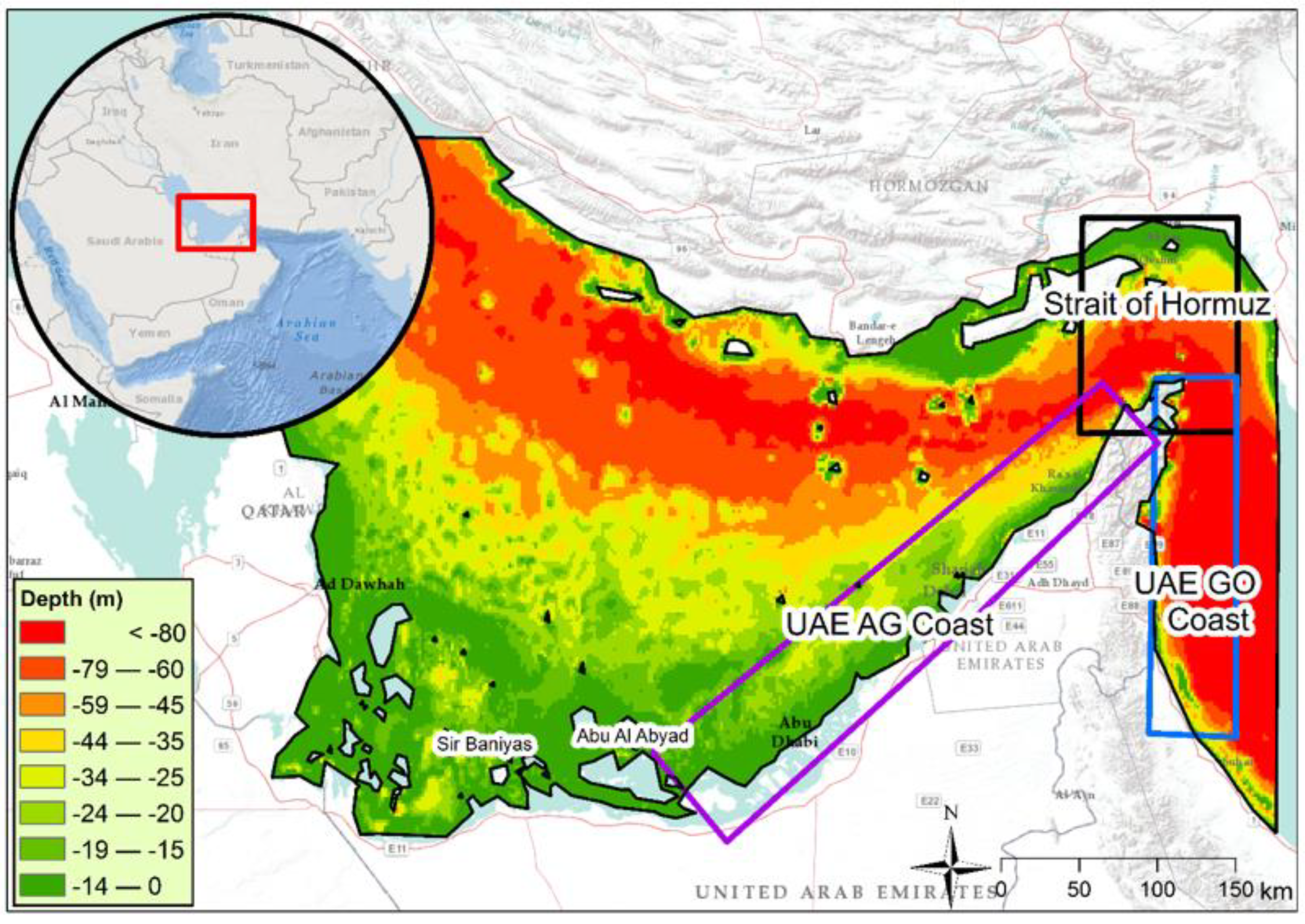
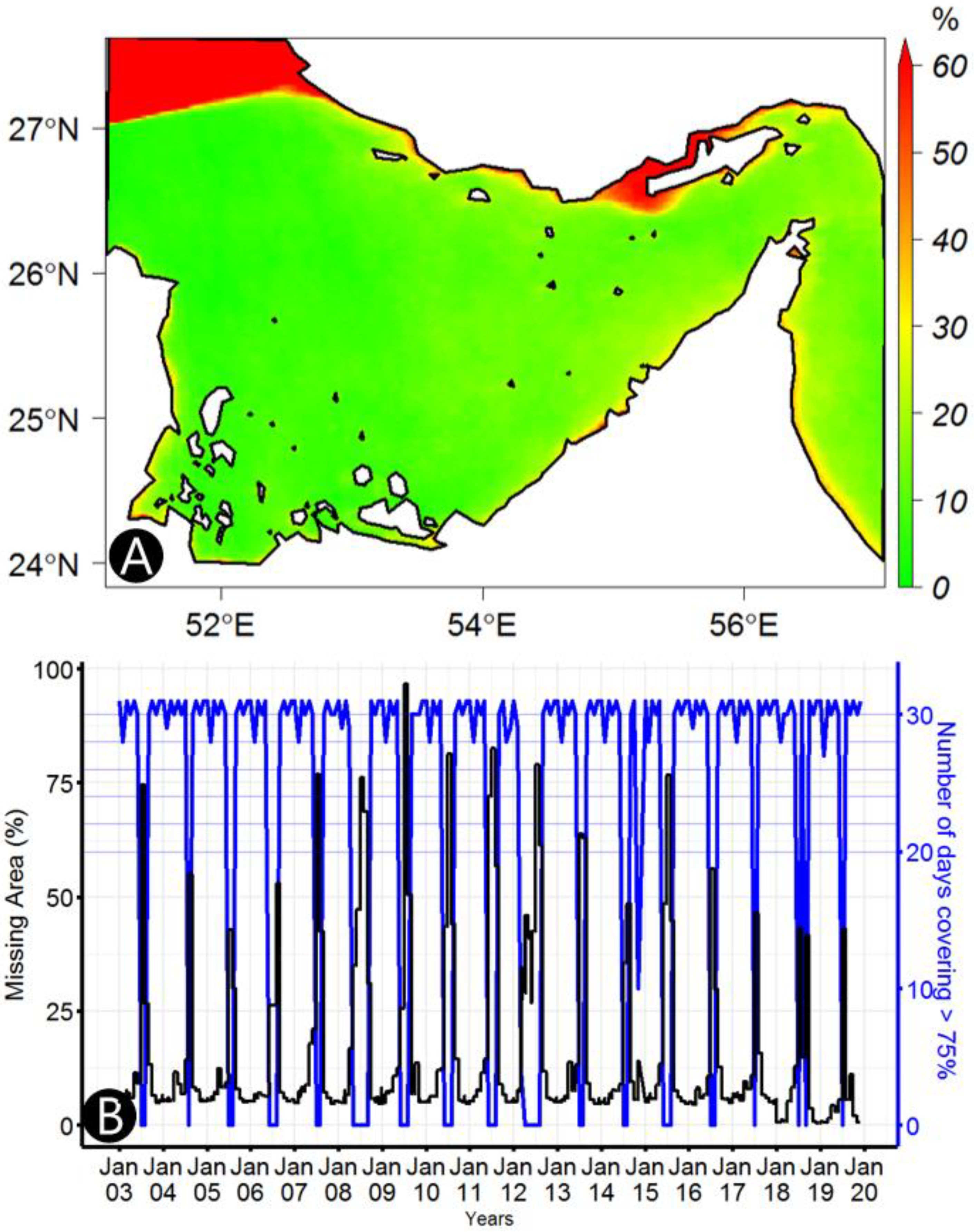
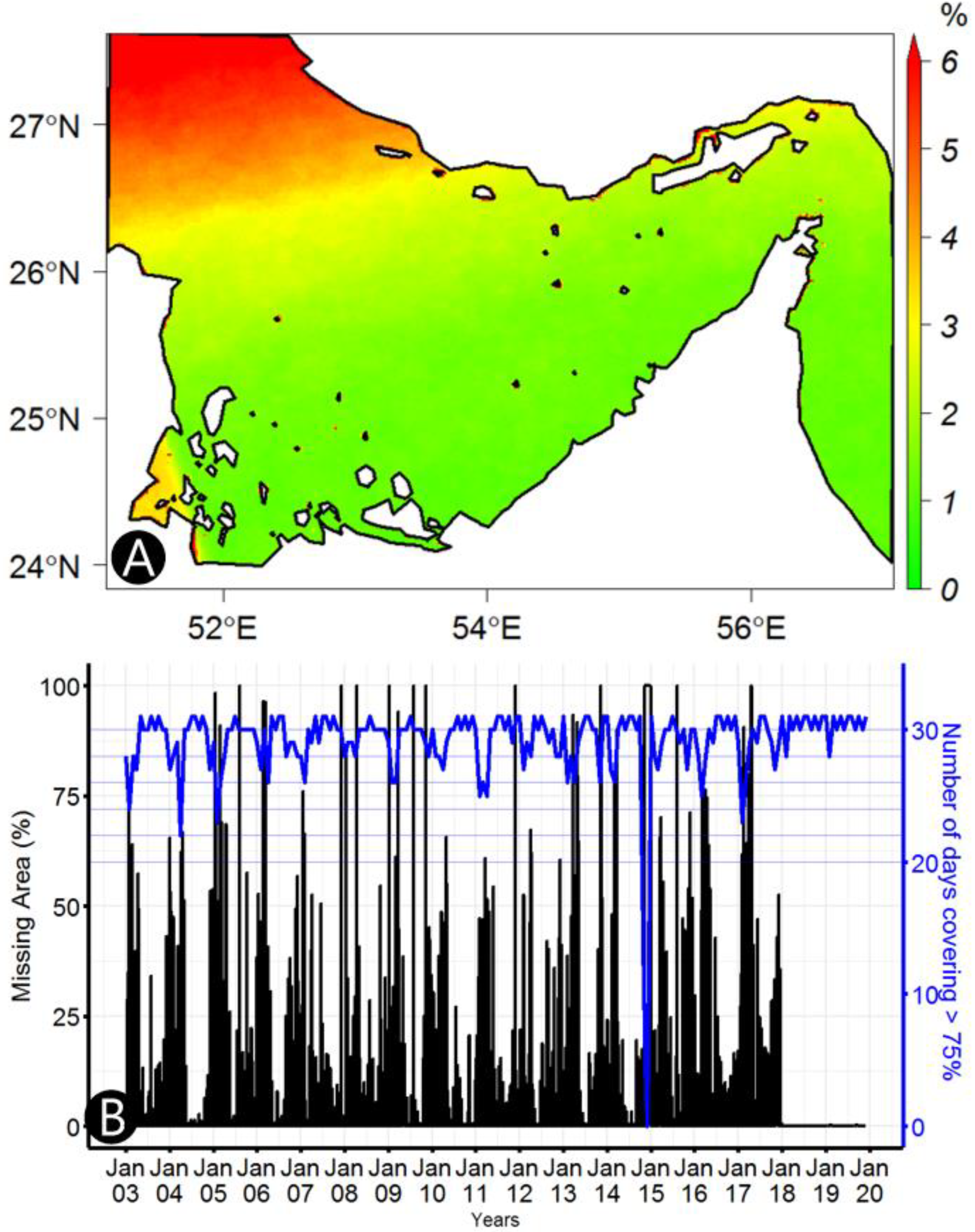
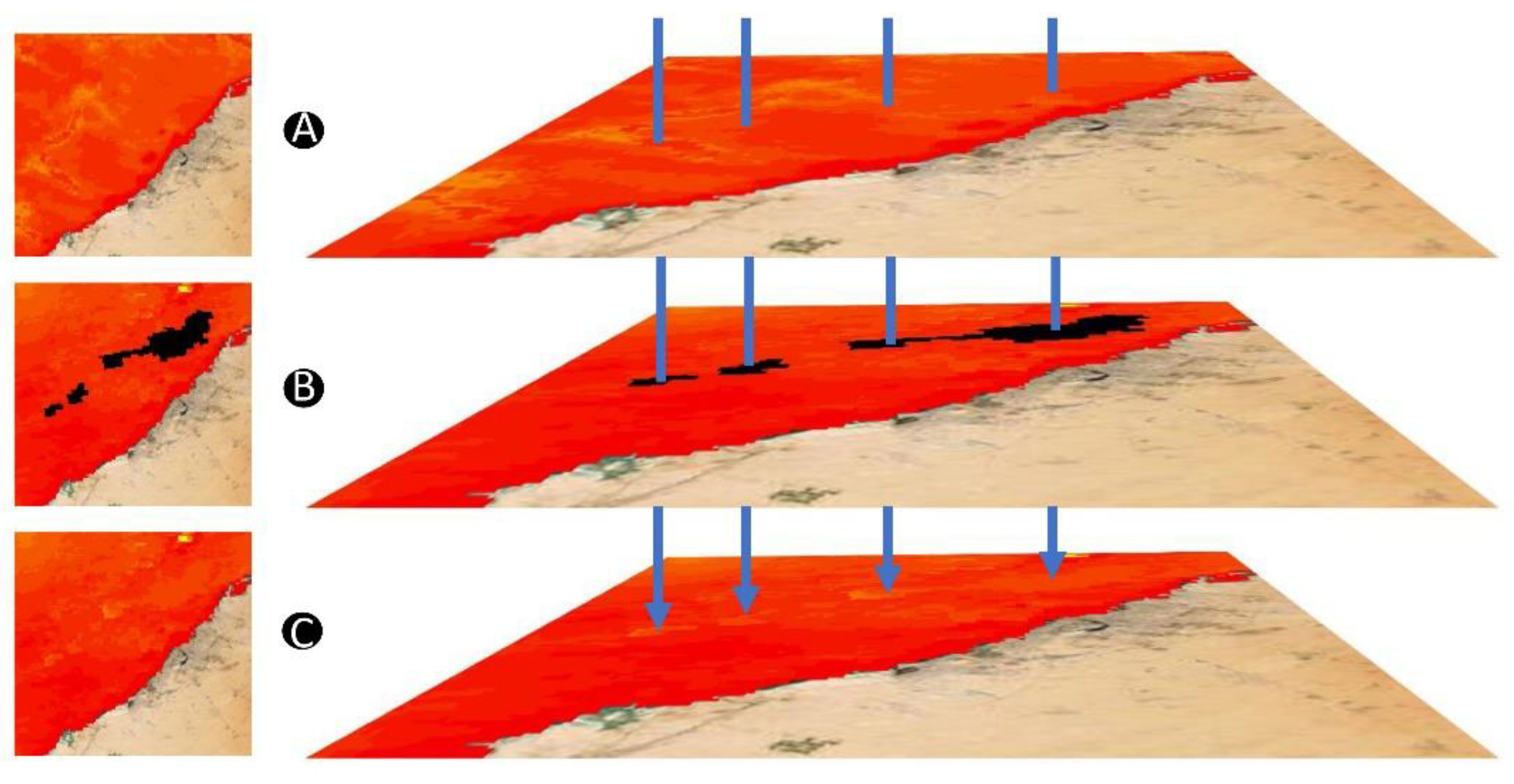
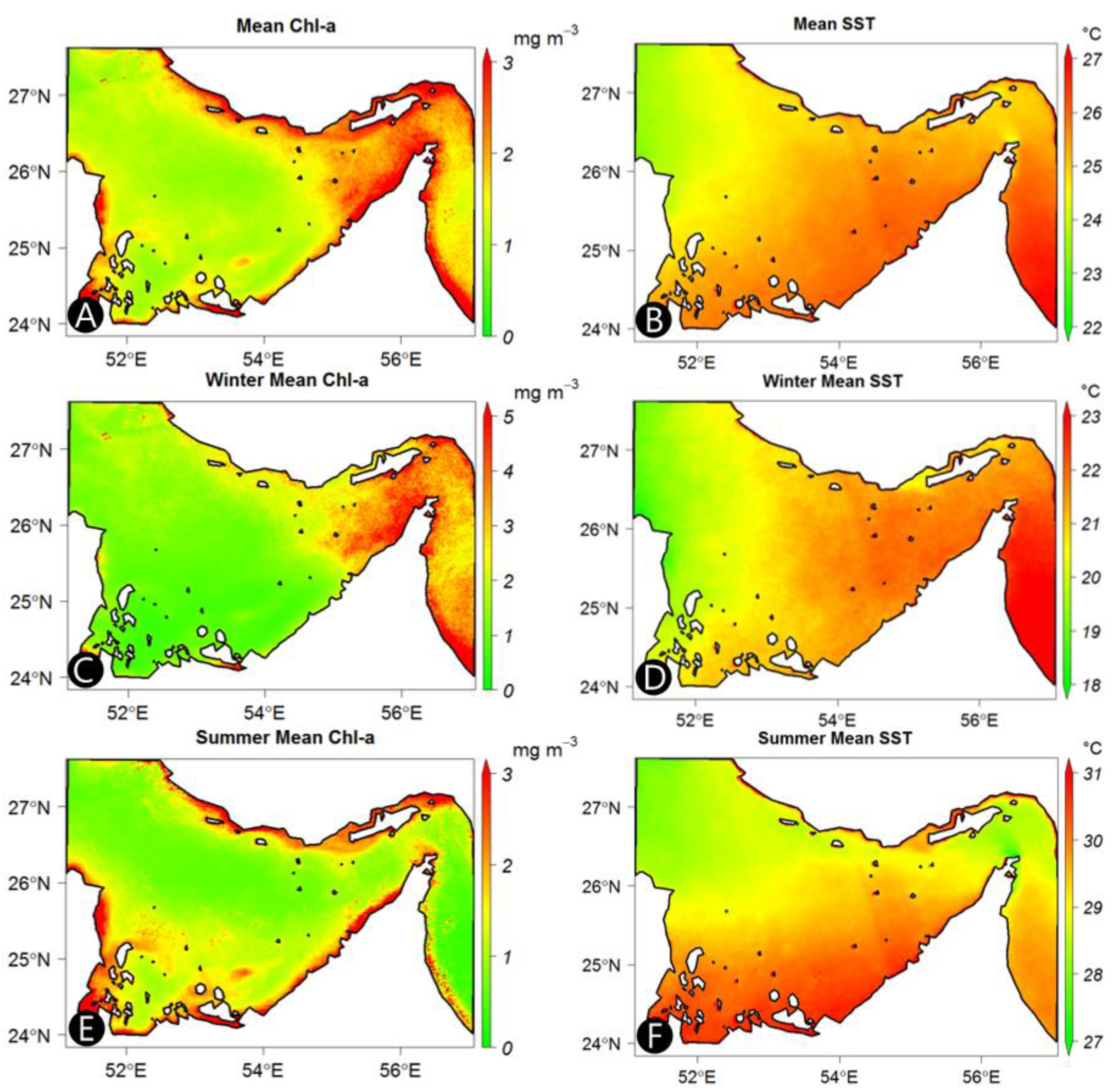
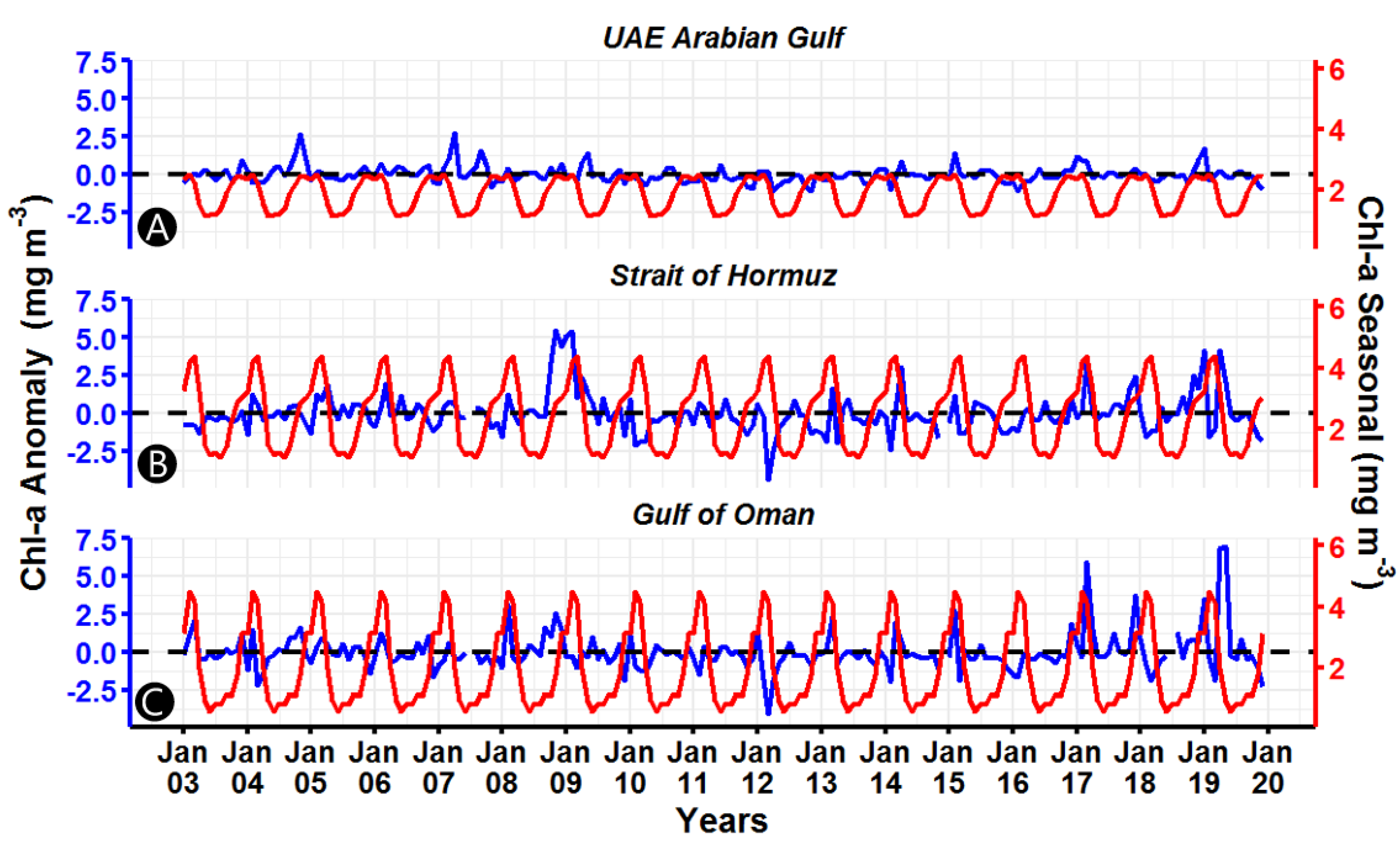
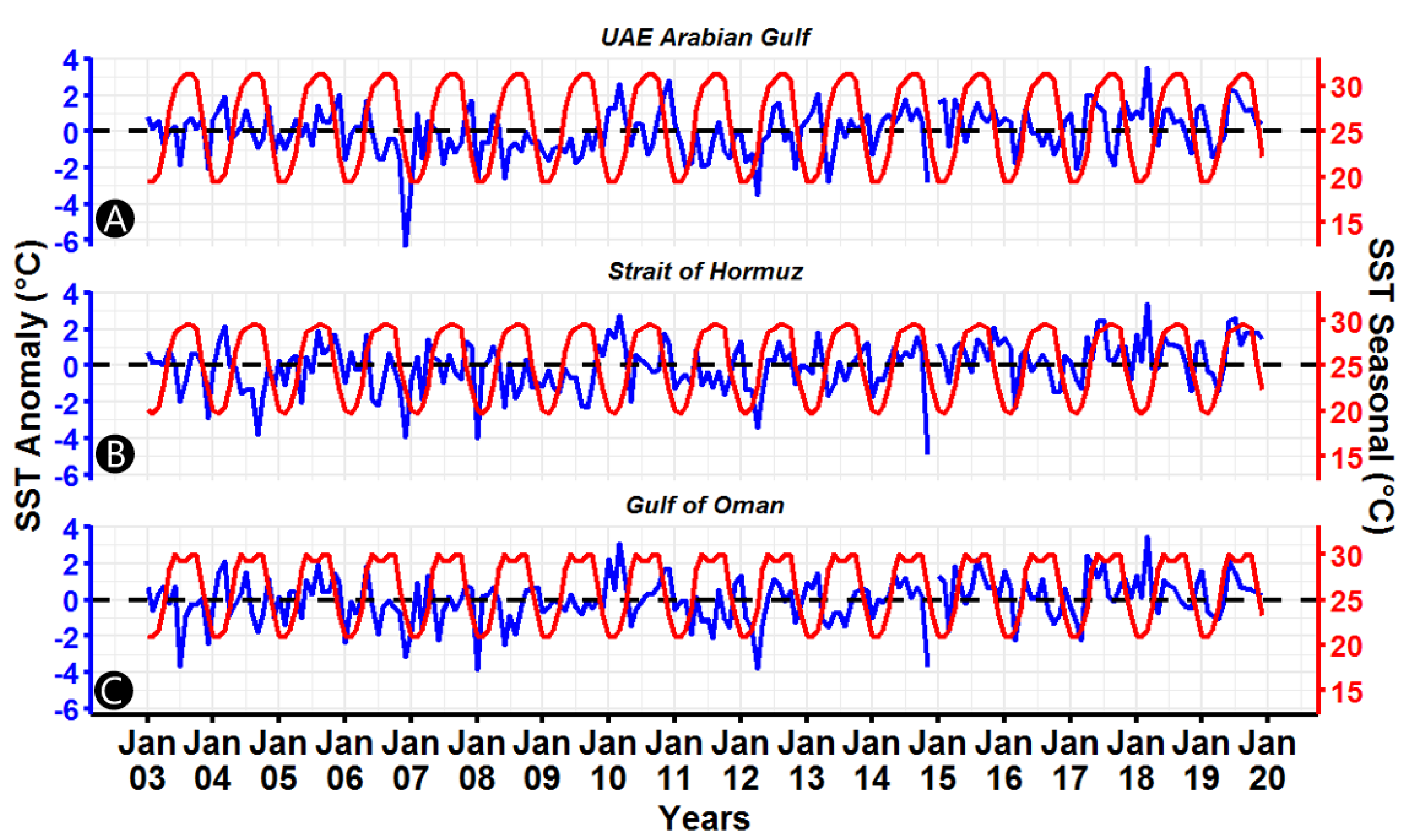
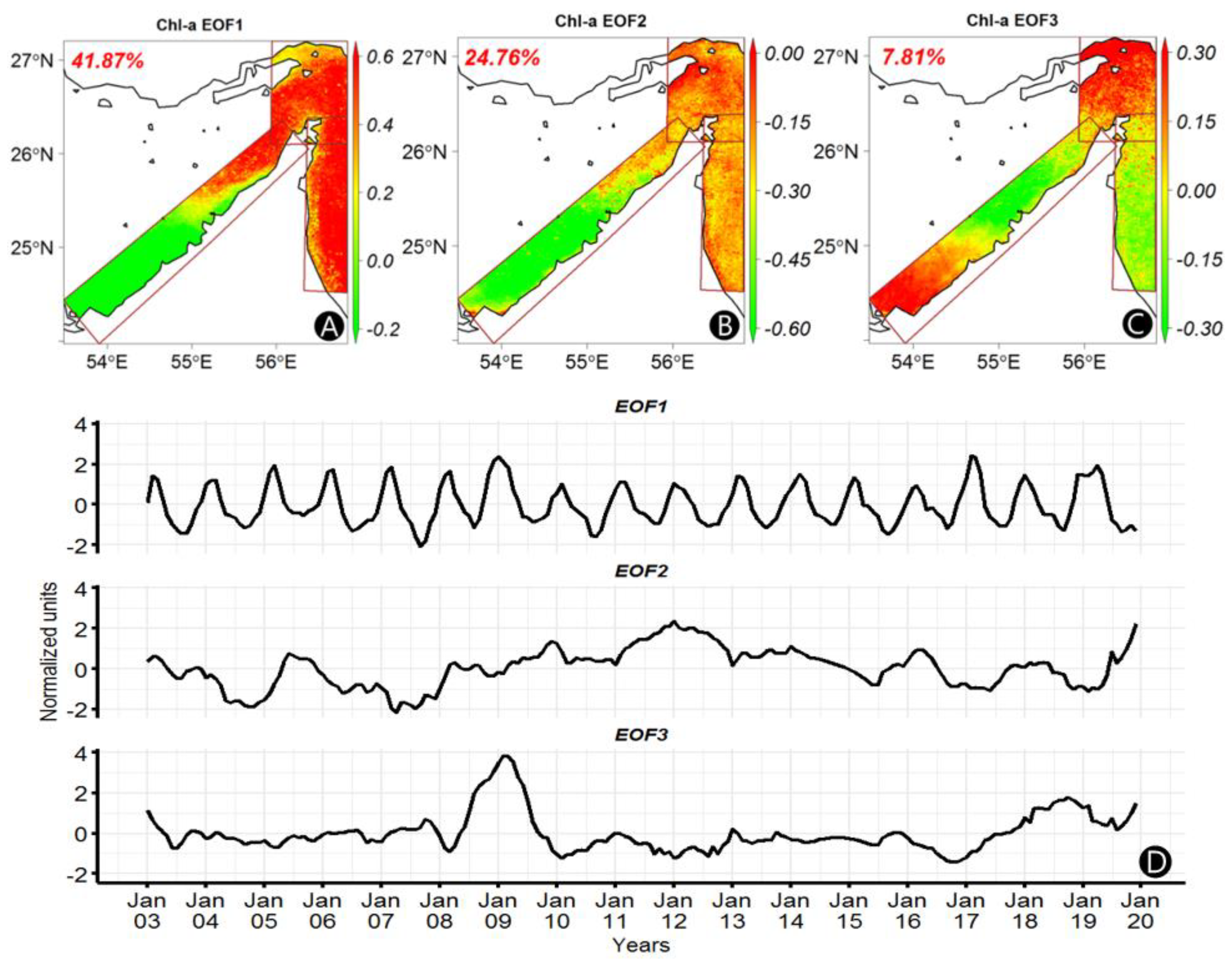
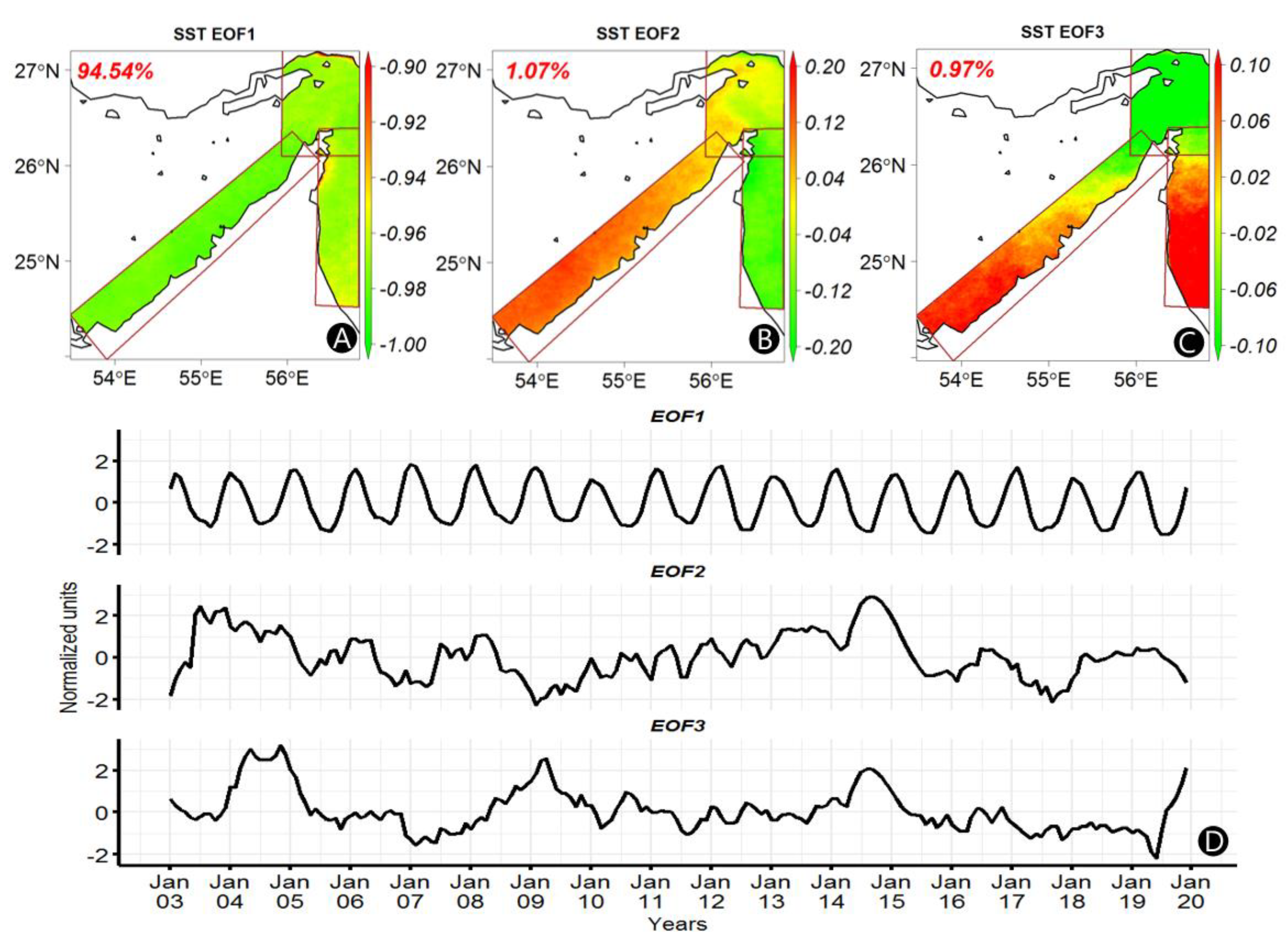
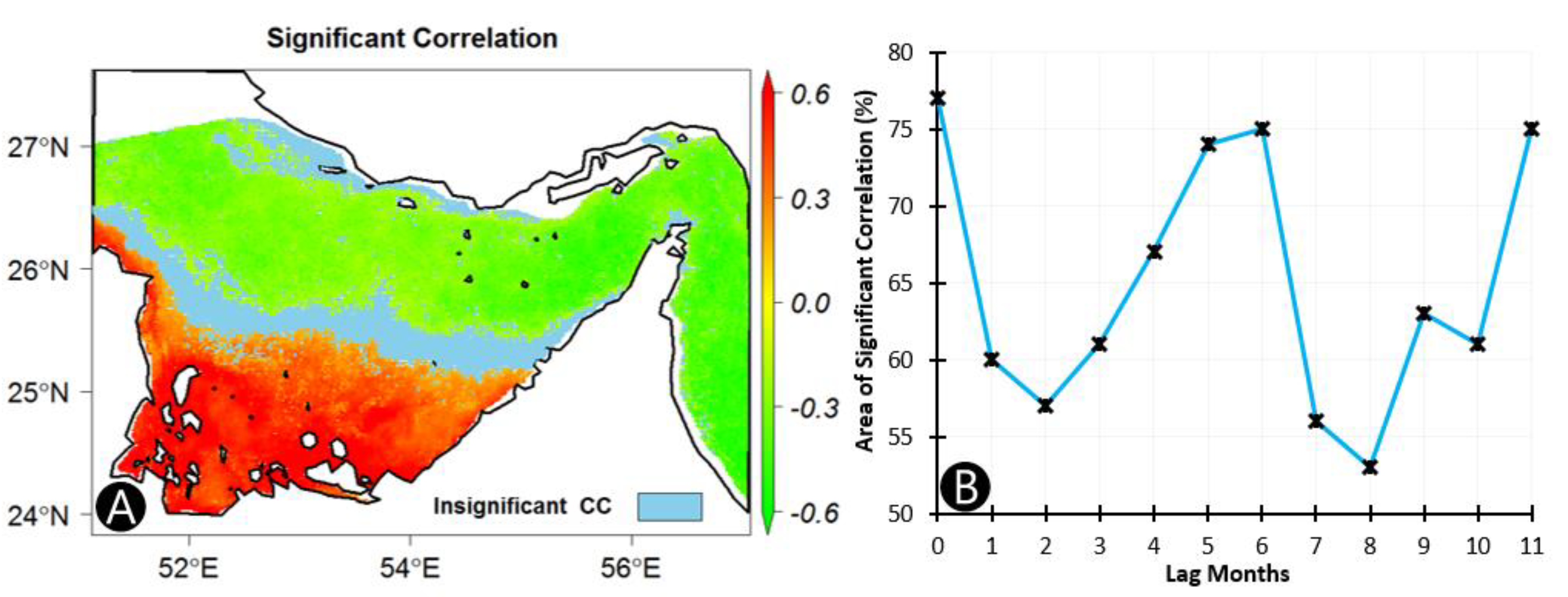
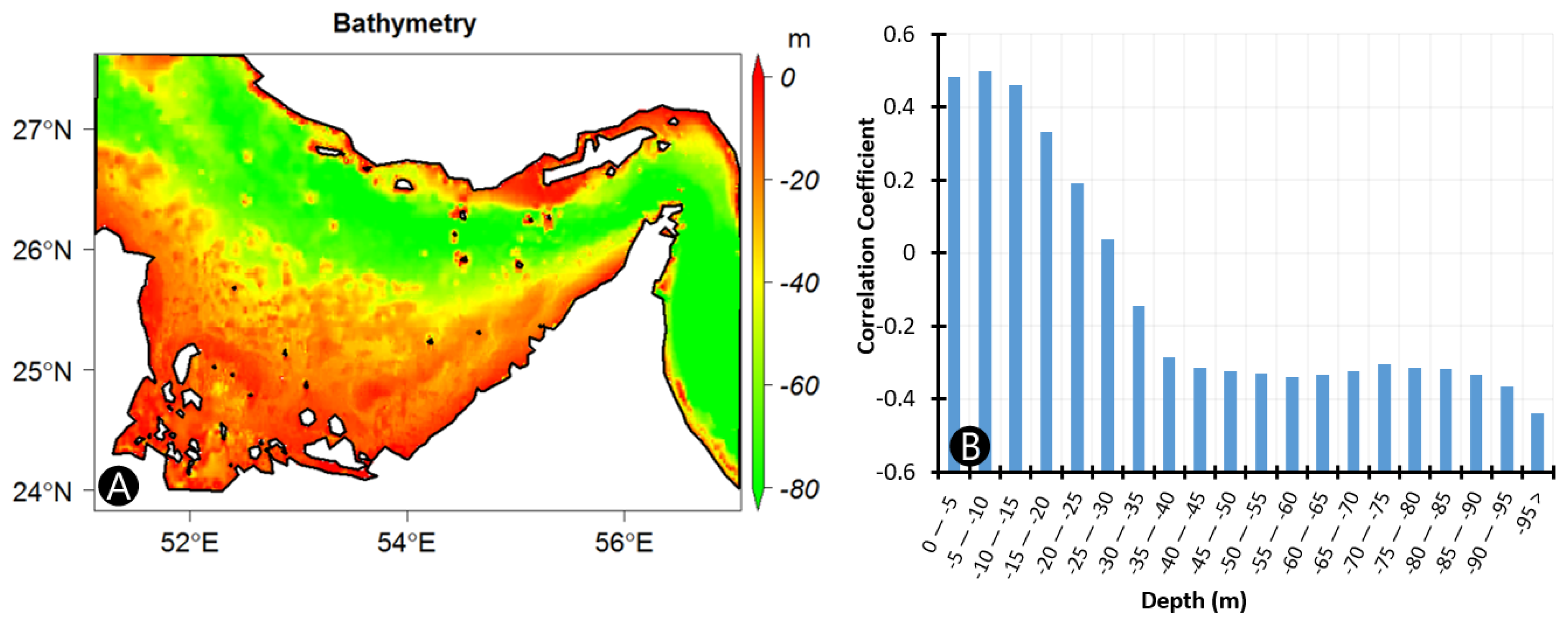
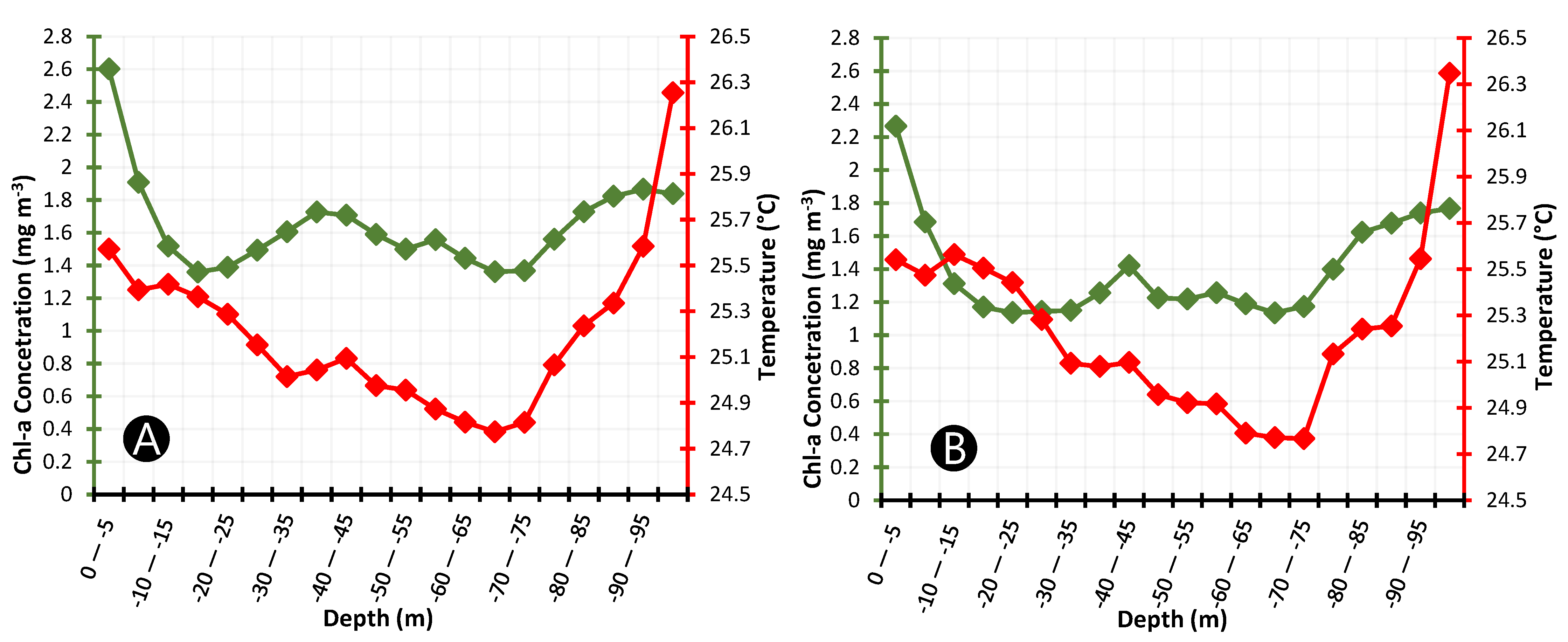
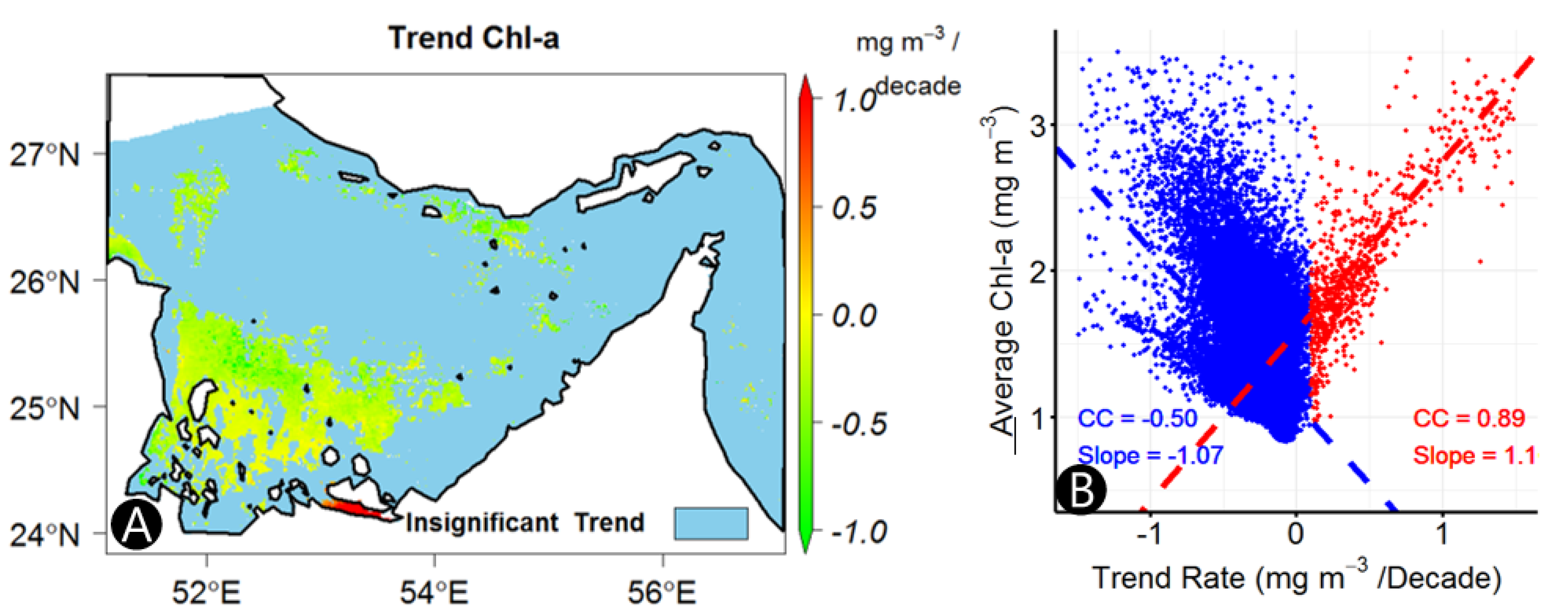
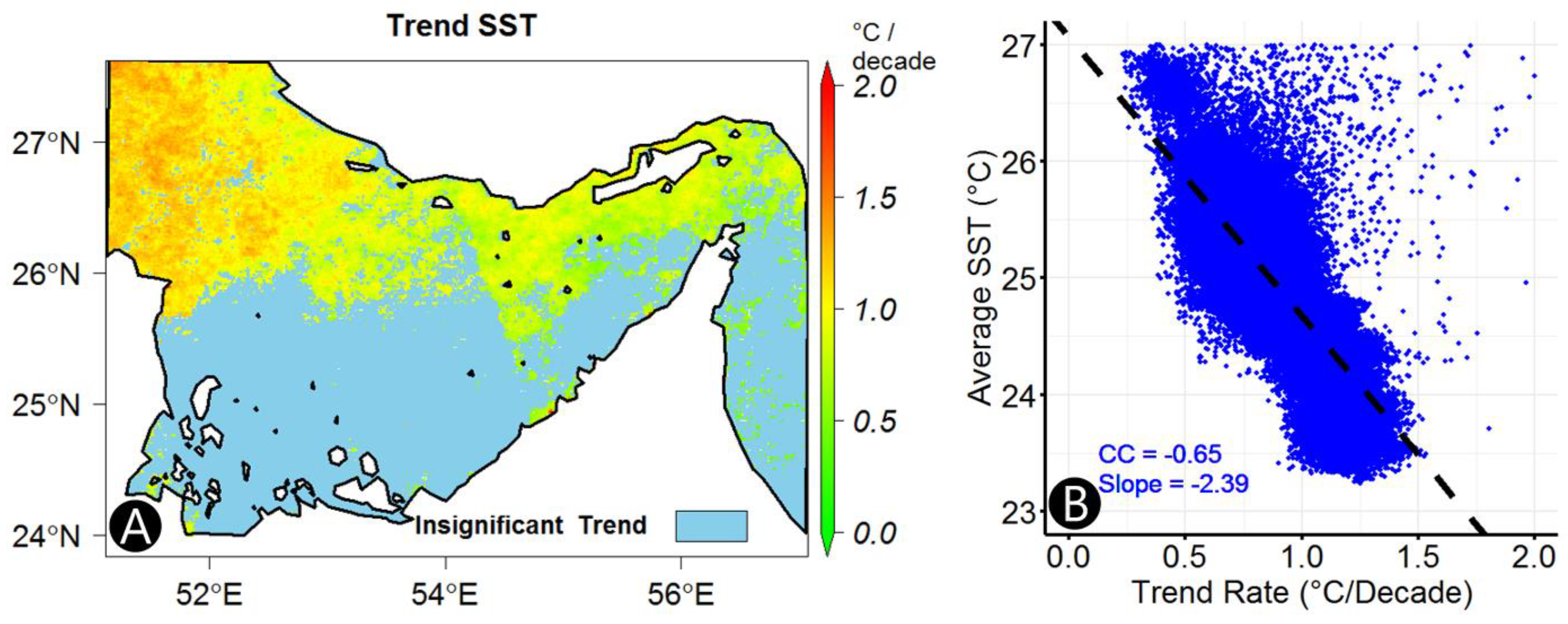


| UAE-Arabian Gulf | Strait of Hormuz | UAE-Gulf of Oman | ||||
|---|---|---|---|---|---|---|
| Average | Median | Average | Median | Average | Median | |
| SST (°C) | 26.0 | 26.0 | 25.2 | 25.1 | 26.2 | 26.2 |
| Chl-a (mg m−3) | 2.00 | 1.8 | 2.8 | 2.6 | 2.3 | 2.0 |
| Depth (m) | −22.8 | −20.0 | −56.7 | −60.0 | −104.7 | −96.0 |
| Correlation Coefficient (CC) | 0.09 | 0.27 | −0.36 | −0.36 | −0.41 | −0.42 |
| Area with positive CC (%) | 47.60 | 0.01 | 0.00 | |||
| Area with negative CC (%) | 30.77 | 80.68 | 81.85 | |||
Publisher’s Note: MDPI stays neutral with regard to jurisdictional claims in published maps and institutional affiliations. |
© 2021 by the authors. Licensee MDPI, Basel, Switzerland. This article is an open access article distributed under the terms and conditions of the Creative Commons Attribution (CC BY) license (https://creativecommons.org/licenses/by/4.0/).
Share and Cite
Hussein, K.A.; Al Abdouli, K.; Ghebreyesus, D.T.; Petchprayoon, P.; Al Hosani, N.; O. Sharif, H. Spatiotemporal Variability of Chlorophyll-a and Sea Surface Temperature, and Their Relationship with Bathymetry over the Coasts of UAE. Remote Sens. 2021, 13, 2447. https://doi.org/10.3390/rs13132447
Hussein KA, Al Abdouli K, Ghebreyesus DT, Petchprayoon P, Al Hosani N, O. Sharif H. Spatiotemporal Variability of Chlorophyll-a and Sea Surface Temperature, and Their Relationship with Bathymetry over the Coasts of UAE. Remote Sensing. 2021; 13(13):2447. https://doi.org/10.3390/rs13132447
Chicago/Turabian StyleHussein, Khalid A., Khameis Al Abdouli, Dawit T. Ghebreyesus, Pakorn Petchprayoon, Naeema Al Hosani, and Hatim O. Sharif. 2021. "Spatiotemporal Variability of Chlorophyll-a and Sea Surface Temperature, and Their Relationship with Bathymetry over the Coasts of UAE" Remote Sensing 13, no. 13: 2447. https://doi.org/10.3390/rs13132447
APA StyleHussein, K. A., Al Abdouli, K., Ghebreyesus, D. T., Petchprayoon, P., Al Hosani, N., & O. Sharif, H. (2021). Spatiotemporal Variability of Chlorophyll-a and Sea Surface Temperature, and Their Relationship with Bathymetry over the Coasts of UAE. Remote Sensing, 13(13), 2447. https://doi.org/10.3390/rs13132447








